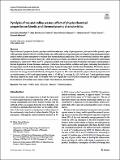Por favor, use este identificador para citar o enlazar a este item:
http://hdl.handle.net/10261/289812COMPARTIR / EXPORTAR:
 SHARE SHARE
 CORE
BASE CORE
BASE
|
|
| Visualizar otros formatos: MARC | Dublin Core | RDF | ORE | MODS | METS | DIDL | DATACITE | |

| Título: | Pyrolysis of tea and coffee wastes: effect of physicochemical properties on kinetic and thermodynamic characteristics |
Autor: | Ben Abdallah, Asma; Ben Hassen Trabelsi, Aïda; Navarro López, María Victoria CSIC ORCID ; Veses Roda, Alberto CSIC ORCID ; García Martínez, Tomás CSIC ORCID ; Mihoubi, Daoued | Palabras clave: | Tea waste Coffee waste Pyrolysis Kinetics Thermodynamics |
Fecha de publicación: | 10-feb-2023 | Editor: | Springer Nature | Citación: | Journal of Thermal Analysis and Calorimetry 148: 2501-2515 (2023) | Resumen: | Physicochemical properties, kinetic pyrolysis and thermodynamic study of spent green tea, pure spent coffee grounds, spent coffee grounds blended with 50% torrefied barley and coffee husk were experimentally investigated using thermogravimetric analysis under an inert atmosphere to evaluate their thermochemical application. Five isoconversional methods were applied to determine effective activation energy (Ea) of the pyrolysis processes. All methods showed good agreement by determining fluctuating Ea values (150–500 kJ mol−1). Complex Ea profiles with conversion were divided into four stages corresponding to thermal degradation of main biomass constituents (extractives, hemicellulose, cellulose and lignin), indicating that extractives decomposition was the least demanding reaction while lignin decomposition was the most demanding. The kinetic process was verified by reconstruction according to the Friedman parameters. The thermodynamic parameters were evaluated to determine the energy demand and efficiency throughout the process. The values obtained for physicochemical properties such as volatile matter (> 68%) and higher heating value (> 17 MJ kg−1), average Ea (223–319 kJ mol−1) and significant energy efficiency implied that these types of biomass waste have significant reactivity and consequently the highest potential for the production of bioenergy and a range of high-value chemicals and materials. | Descripción: | 8 figures.-- Supplementary information available. | Versión del editor: | http://dx.doi.org/10.1007/s10973-022-11878-4 | URI: | http://hdl.handle.net/10261/289812 | DOI: | 10.1007/s10973-022-11878-4 | ISSN: | 1388-6150 | E-ISSN: | 1588-2926 |
| Aparece en las colecciones: | (ICB) Artículos |
Ficheros en este ítem:
| Fichero | Descripción | Tamaño | Formato | |
|---|---|---|---|---|
| s10973-022-11878-4.pdf | Artículo principal | 1,72 MB | Adobe PDF |  Visualizar/Abrir |
| 10973_2022_11878_MOESM1_ESM.pdf | Información suplementaria | 1,02 MB | Adobe PDF |  Visualizar/Abrir |
CORE Recommender
SCOPUSTM
Citations
9
checked on 29-abr-2024
WEB OF SCIENCETM
Citations
6
checked on 22-feb-2024
Page view(s)
47
checked on 03-may-2024
Download(s)
29
checked on 03-may-2024
Google ScholarTM
Check
Altmetric
Altmetric
Este item está licenciado bajo una Licencia Creative Commons



